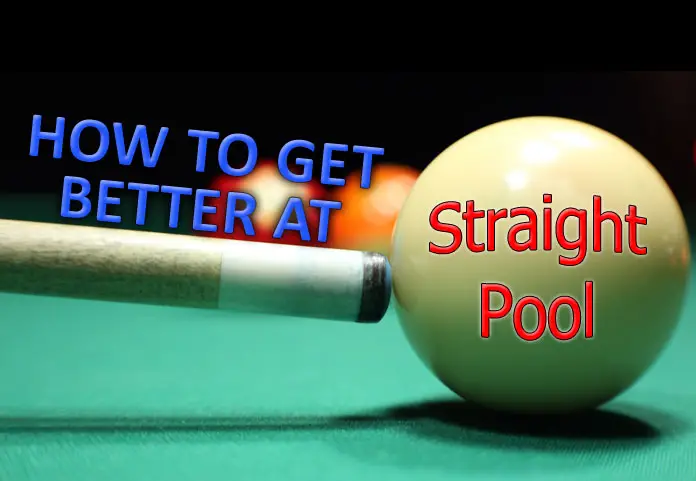Straight Pool is another popular pocket billiards game in the US. It is also called 14.1 Continuous Pool.
While this game was once the most popular of pool games, its popularity has diminished somewhat with the advent of televised pool games.
It is a game that can be somewhat boring when watched on TV, while 8-ball and 9-ball just naturally seem to generate some tougher and more interesting shots, thereby keeping the audience’s interest.
Straight pool uses the standard 15 balls in a triangle rack. 14.1 continuous is one of the few games where the winner of the lag or coin toss may give the right to break back to the challenger. This is a call-your-shot game, including calling a ball on the break.
For this reason, experienced players often play a safety on the break instead of trying to explode the balls all over the table. To prevent half-hearted breaks and to get the game going, the rules stipulate that the cue ball and at least two object balls must touch a rail during the break, or a foul is called.
In this case, the opponent has the option of either making the shooter break the rack again or taking over the turn with the table left as is. A two-point penalty is assessed to the original breaker for this foul.
The object of straight pool is to be the first player to legally pocket the agreed number of balls, be it 100, 150, or whatever. Each ball sunk counts as one point and the ball and pocket must be called. “Slop”, as I call it, is allowed, meaning that combinations, kisses, caroms, and rail hits are legal and need not be specified, as long as the called ball goes into the called pocket.
Unlike many other pool games, any ball may be shot an any time. As long as the object ball is pocketed, any additional balls that go in are also credited to the shooter.
Players continue to shoot as long as they continue to legally sink balls. When 14 of the 15 balls of a rack are sunk, play is halted while the balls are re-racked. After the racked balls are in position on the foot spot, the player resumes shooting.
His goal is to sink the 15th ball of the first rack while simultaneously breaking the re-racked balls with the cue rebound, thus giving giving him more shots to continue.
This is where the “14.1 continuous” name comes from – 14 balls are pocketed while 1 ball is saved for the next rack to make a “continuous” game. The game goes on in this fashion until one player reaches the agreed number of balls and wins the game.
In straight pool, an object ball in a strategic position is carefully left as the 15th ball by experienced straight pool players. Along with a good cue ball position on the table, this is important, to insure that the rack is broken sufficiently when this 15th ball is shot. While any ball may be shot at, even at this point in the game, it is very difficult to call a particular shot of a ball in the rack with confidence.
If the 15th ball or the cue ball are positioned on the table where the new rack will go, they must be moved. In this case, the 15th object ball is placed on the foot spot at the head of the rack, or, if it is the cue ball that must be moved, it is placed anywhere behind the headstring.
Strategy
- If you win the lag or coin toss, have your opponent break.
- If you must break, hit the rack just hard enough to cause the cue ball and two of the object balls to hit a rail. If done right, this will cause the two object balls to rebound back almost to their original positions in the rack, making your opponent’s shot more difficult.
- Make the easy and short shots first to build up your points.
- Sink balls at the rack end of the table first to clear the way for future shots.
- Try to break up groupings of balls with the cue rebound as you shoot, to avoid a problem shot later on.
- Of course, if you don’t have a decent shot, play the best safety you can.
- Keep an eye out for the ideal ball to leave as your last ball on the table, so you can get a good breakout of the next rack. Cue position is also critical to hitting this ball to best advantage.
General Tips
- Consider playing safe instead of going for a low percentage shot
- Choose “Solids” or “Stripes” wisely after the break
- Pocket balls in groups to avoid having to go up and down the table
- Think 3 shots ahead, not just 1 or 2
- Have a plan but re-evaluate after every shot
We have more playing tips on how to better your game.
Need help buying a pool cue or table? There are plenty of options available.

